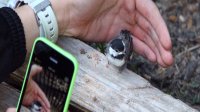Connecting iGeneration to the Natural World
Ignite student passion for the natural world with fieldwork apps, turning your kids into citizen scientists who observe, hypothesize, identify, and share information about nature.
Your content has been saved!
Go to My Saved Content.The Urban iGeneration
On Monday mornings, as the kids wipe the sleep out of their eyes and finish their morning routines, I like to check in about what they were up to over the weekend. Teaching in a city, I find that students will often share about a birthday party or practice they attended, and their video game triumphs. What's absent from most of these check-ins are anecdotes from the forest, local creek, beach, or backyard.
Unlike my own childhood, which was filled with digging holes in the backyard, hunting insects, and rolling around in the grass, my students lead a largely indoor life. At first offer, they would much rather power up the video game system, snap selfies, or watch YouTube videos than go newt hunting. I've even witnessed students so alarmed by insects and living organisms that they duck and cover when in the vicinity of a common housefly. In short, these students are often disconnected from and fearful of nature.
But I've also watched these same students, when given the opportunity, indulge in planting a flower, identifying a beetle, or even heading to the beach for a cleanup. To do this, they need not abandon their devices. Rather, the key to bridging this gap is integrating familiar technologies. Using portable devices, the iGeneration can engage with and learn about the natural world around them.
Bridge or Barrier
Some may consider this technology to be a distraction or barrier, but I've witnessed how it can catalyze interest and enthusiasm around doing fieldwork in nature. Last year, I took my students to a local watershed to identify native plants. One half of the class used pencil and paper data collection sheets, while the other used an app called iNaturalist to snap photos of organisms and note observations. They were immediately able to geotag their location and share their findings with the web-based naturalist community in hopes of getting help with identification.
Both groups were essentially partaking in the same task, but one group was far more engaged and enthusiastic than the other. While the analog groups sat quietly observing, the digital groups were excitedly sharing their observations and comparing pictures. Upon returning to school, the kids who'd used the app waited anxiously for an identification by the iNaturalist community.
Citizen Scientists
Mobile technology was a powerful teaching tool to introduce and encourage core scientific practices such as observing, hypothesizing, identifying, and sharing information, all while submerged in nature. There was a spark in the air, and it was contagious. All students were pining to go into the field again with the devices. Students were self-identifying and using the app on weekends. With this developing connection also came a growing sense of stewardship about the natural world around them. It went beyond the technology supporting science practices like observing and identifying, also fostering conservation goals among the students. I noted higher levels of curiosity about birds and plants in our schoolyard, and a developing sense of stewardship toward our newly recognized neighbors.
Apps for Your Naturalists
With the rapid pace at which apps are being developed, the future is full of ways to further engage our students in nature. With cellphones becoming even more ubiquitous, there's still an opportunity to turn the attention of young minds toward the outdoors. Teachers who put accessible guides and observation tools at our students' fingertips have the chance to turn members of iGeneration into the next generation of naturalists, citizen scientists, and conservationists.
There is a plethora of apps out there that are useful for scientific fieldwork. Here's a short list to get you started. A quick tip to help ensure success: try using these apps on your own before starting with your students, and give them a chance to get familiar before heading into the field. However you introduce your students to this technology, I'm sure that you'll find it a gateway to the natural world that surrounds them.
iNaturalist (iOS or Android - Free)
Users of this app make some observations and take a photo of an organism. The app includes a field guide, or you can submit what you observed to the iNaturalist community for identification. You can then keep a log of what you've identified, like a digital species collection, without the having to injure any plants or animals.
Nature's Notebook (iOS or Android - Free)
Another great app for finding and recording wildlife in your area is Nature's Notebook. One difference between iNaturalist and Nature's Notebook is that you can track and study phenology, key seasonal changes in plants and animals.
Marine Debris Tracker (iOS or Android - Free)
Humans create waste and garbage, a lot of which ends up in the ocean, creating environmental hazards, endangering wildlife, and interfering with navigation. After downloading the data collection tool called Marine Debris Tracker, kids can categorize the marine debris that they find, and upload that information to the database.
Leafsnap (iOS - Free)
Leafsnap is an electronic field guide that uses visual recognition software to identify plants. Students can take pictures of plant parts to identify a species, or use the extensive electronic field guide to do their own research.
Have you used mobile technology to carry out fieldwork with youth? What strategies and apps have worked best for you? Please share in the comments section below.
